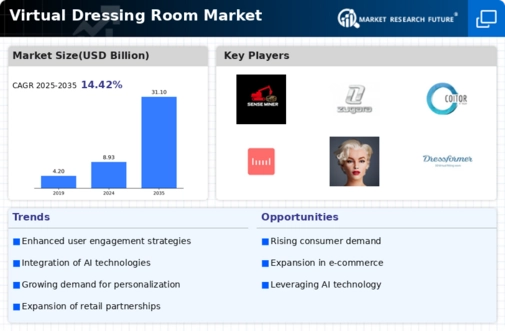Virtual Dressing Room Market Summary
As per Market Research Future Analysis, the Virtual Dressing Room Market was valued at USD 5.5 billion in 2021 and is projected to grow from USD 6.2 billion in 2022 to USD 15.87 billion by 2030, with a CAGR of 14.42% during the forecast period. The market is driven by the integration of Augmented Reality (AR) and Virtual Reality (VR) technologies, enhancing online shopping experiences. The e-commerce sector is a significant contributor, with physical stores also witnessing rapid adoption of virtual fitting room technologies. Key players are focusing on R&D and strategic initiatives to expand their market presence.
Key Market Trends & Highlights
The Virtual Dressing Room market is experiencing transformative trends driven by technology and consumer preferences.
- 71% of consumers prefer brands that integrate AR into their shopping experience.
- The Solutions segment accounted for ~57% of the market revenue in 2021.
- The Asia-Pacific region is expected to grow at the fastest CAGR from 2022 to 2030.
- Physical stores are the fastest-growing segment due to advanced interactive technologies.
Market Size & Forecast
| 2021 Market Size | USD 5.5 Billion |
| 2022 Market Size | USD 6.2 Billion |
| 2030 Market Size | USD 15.87 Billion |
| CAGR | 14.42% |
Major Players
Key companies include Stray Vista Studios, SenseMi, Zugara, Inc., Coitor IT Tech, REACTIVE REALITY GMBH, Fit Analytics, 3DLOOK Inc., and others.


















